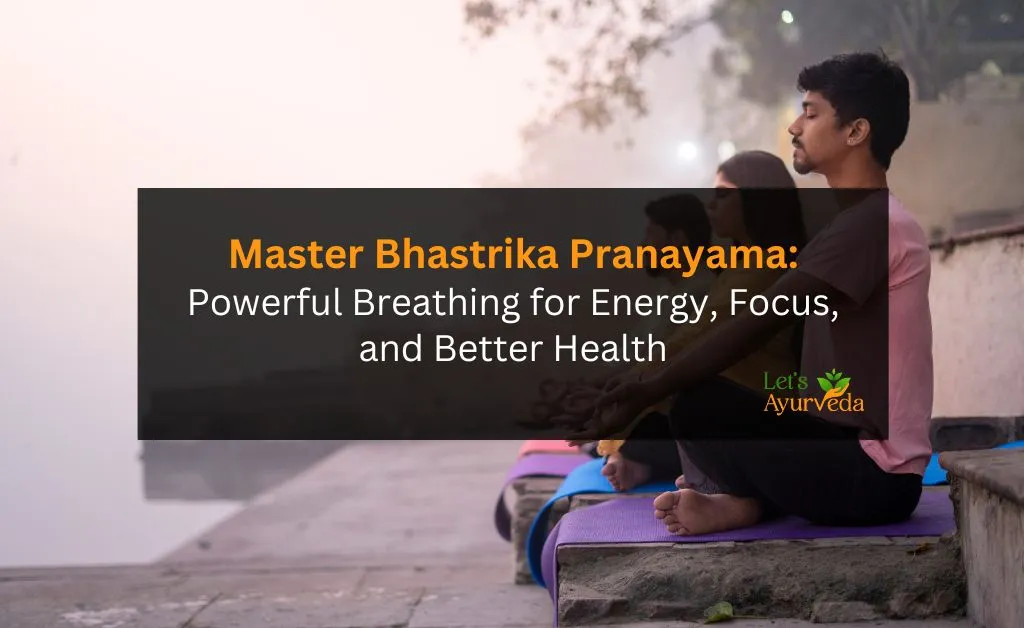Introduction
Bhastrika Pranayama, often referred to as "Bellows Breath," is one of the most powerful breathing exercises in yoga. Derived from the Sanskrit word Bhastrika, meaning “bellows,” this pranayama involves forceful inhalations and exhalations, much like how bellows pump air into a fire to make it burn brighter.
It’s a practice known for its energizing effects on the body and mind, providing multiple benefits for physical and mental health. In today’s fast-paced world, Bhastrika offers a simple but effective way to revitalize your system, calm your mind, and improve your overall well-being.
In this blog post, we’ll break down the benefits of Bhastrika Pranayama and walk you through easy-to-follow steps so you can incorporate it into your daily routine.
What is Bhastrika Pranayama?
Bhastrika Pranayama is a traditional breathing exercise where deep, forceful breaths are taken in a rhythmic fashion. It involves vigorous inhalation followed by rapid exhalation, which helps to increase the oxygen intake and expel toxins from the body.
Unlike other calming pranayama techniques like Nadi Shodhana or Anulom Vilom, Bhastrika is known for its quick, stimulating, and energizing effects. It’s ideal for those looking to boost their energy levels, clear mental fog, or prepare their bodies for meditation or physical activity.
Key Benefits of Bhastrika Pranayama
1. Boosts Lung Capacity and Strengthens Respiratory System
Bhastrika pranayama requires you to breathe deeply and forcefully, which naturally enhances lung capacity. Over time, it strengthens the muscles that help with breathing, such as the diaphragm and intercostal muscles. This can improve your overall respiratory efficiency, making it easier to perform physical activities and reducing breathlessness.
Studies show that regular pranayama practice, including Bhastrika, can improve respiratory function in individuals with asthma and bronchitis, helping them breathe easier and more comfortably.
2. Increases Oxygen Supply and Detoxifies the Body
One of the core aspects of Bhastrika Pranayama is the rapid and forceful exchange of air, which floods the body with oxygen. This increased oxygen supply stimulates every cell, helping to flush out toxins and waste products more efficiently. By eliminating carbon dioxide, it also creates a fresh flow of energy, giving you a sense of vitality and rejuvenation.
Oxygenation is crucial for brain function, so the increased oxygen supply can improve concentration, memory, and cognitive clarity. Many people report feeling more awake and alert after practicing Bhastrika.
3. Energizes the Body and Mind
Unlike slower pranayamas, Bhastrika is stimulating and energizing. It increases circulation, elevates heart rate, and sends a rush of energy throughout the body. This can be especially beneficial when you're feeling sluggish or fatigued, as it quickly wakes up both your body and mind.
It's often recommended as a morning breathing exercise to kickstart your day, providing a natural boost of energy without the need for caffeine or stimulants.
4. Balances Nervous System
Bhastrika has a powerful effect on the autonomic nervous system, particularly in balancing the sympathetic (fight or flight) and parasympathetic (rest and digest) responses. While the practice is invigorating, it also helps to reduce anxiety and stress over time, bringing about a sense of calm after the session.
In today’s stressful world, this balance is key to maintaining overall well-being. According to studies, consistent pranayama practice has been linked to lower levels of cortisol, the stress hormone, thus making Bhastrika an effective way to manage stress and anxiety.
5. Improves Digestion and Circulation
Bhastrika pranayama stimulates the abdominal organs due to the forceful movements involved in the breathing process. This helps to improve digestion by massaging the digestive organs and increasing blood flow to the stomach, intestines, and liver. As a result, it can enhance metabolic function and alleviate common digestive issues like bloating or indigestion.
Additionally, the rhythmic breathing encourages better circulation throughout the body, ensuring that oxygenated blood reaches vital organs and muscles, aiding in their optimal function.
6. Prepares the Mind for Meditation
After the energizing effects of Bhastrika, many people experience a calming, centered state that is ideal for meditation. The increased oxygen and reduced stress levels make it easier to focus inward and achieve a deeper, more fulfilling meditation session.
Whether you’re just starting out with meditation or looking to enhance your current practice, Bhastrika pranayama is an excellent preparatory step.
Steps to Practice Bhastrika Pranayama
Now that we’ve covered the benefits, let’s go over how you can start practicing Bhastrika pranayama. It’s important to note that this pranayama can be quite stimulating, so start slow, especially if you’re new to the practice.
Step 1: Choose a Comfortable Position
Sit in a comfortable cross-legged position, such as Sukhasana (easy pose) or Padmasana (lotus pose). Keep your back straight, your shoulders relaxed, and your hands resting on your knees in Gyan Mudra (thumb and index finger touching).
Step 2: Focus on Your Breath
Before you begin Bhastrika, take a few slow, deep breaths to center yourself. Inhale deeply through the nose, and exhale completely through the nose. This helps prepare your lungs for the more forceful breathing to come.
Step 3: Inhale Forcefully
Take a deep, forceful breath in through both nostrils. Make sure your abdomen expands as you breathe in. The inhalation should be quick but controlled, with a focus on drawing in as much air as possible.
Step 4: Exhale Rapidly
Immediately after the inhalation, exhale forcefully and rapidly through the nose. Pull your navel in toward your spine as you push the air out. The exhalation should be as strong as the inhalation, with the same sense of intensity.
Step 5: Repeat in Sets
Continue inhaling and exhaling in this forceful manner. Beginners can start with 10-15 breaths per round, working their way up to 20 breaths per round as they gain more practice. After completing one round, rest for a minute before starting the next round. Aim for 2-3 rounds in total.
Step 6: Cool Down
After completing your rounds of Bhastrika, close your eyes and breathe naturally for a few minutes. Observe the changes in your body and mind. You should feel both energized and calm.
Important Tips for Safe Practice
-
Practice on an Empty Stomach: It’s best to perform Bhastrika Pranayama on an empty stomach, preferably in the morning.
-
Practice Under Expert Guidance: Especially if you're new to pranayama, it's recommended to practice Bhastrika under the guidance of a qualified yoga teacher to ensure correct technique and avoid injury.
-
Avoid Overexertion: If you feel dizzy or lightheaded during the practice, stop and take a break. It's important to listen to your body and not push yourself too hard.
-
Consult a Doctor if Needed: If you have any pre-existing health conditions like hypertension or heart issues, consult your doctor before incorporating Bhastrika into your routine.
Conclusion
Bhastrika Pranayama is an ancient yet effective breathing exercise with numerous benefits for both body and mind. Whether you're looking to increase your energy, improve your lung function, or calm your nervous system, this pranayama is a powerful tool that can help. By practicing regularly and following the steps outlined above, you’ll be well on your way to experiencing the full range of benefits Bhastrika has to offer. So, why not start today?






